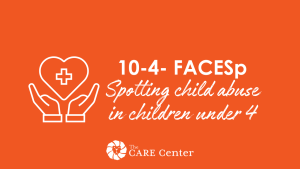Even young children can begin to practice mindfulness, which calms down the nervous system and helps the child feel more centered and secure.
If a child is in a hospital and activities are restricted, such as going outside or vigorous play with many toys, mindfulness can be a great way to provide some enjoyment to the child, as well as connect with them and increase their comfort and security while in the hospital.
Below are various mindfulness activities that can be used with young children.
Pizza Breathing (2-15 minutes)
Deep breathing can help a young child connect with their body and settle their mind. It may also calm them when feeling dysregulated.
- Have the child imagine a pizza. You may talk about what kind of pizza they like, or what toppings they want on the pizza.
- Hold imaginary pizzas out in front of you.
- Take a deep breath in through your nose, and tell the child to imagine that they are breathing in the delicious smell of warm pizza straight out of the oven.
- Exhale out through your mouth, and tell the child to imagine that they are blowing on the pizza to cool if off.
- Repeat this several times
This activity can be extended for slightly older children by having them draw or make a pizza with construction paper prior to practicing the breathing. They can even cut out toppings and paste them on.
You can also replace “pizza” with any other hot food, such as a soup or a cookie.
Balloon Breathing (about 2 minutes)
Deep breathing can help a young child connect with their body and settle their mind. It may also calm them when feeling dysregulated. Do this activity alongside the child, as your modeling and engagement will help them actively participate. You can do this activity sitting, standing, or laying down.
- Start by placing your hands on the top of your head, and instructing the child to do the same.
- As you breathe in, filling up your stomach, raise your hands above your head slowly, as if you are blowing up a large balloon.
- When you are finished with your inhale, your arms should resemble a large balloon on top of your head.
- When you exhale, slowly bring your hands down towards your head, coordinating your breath with the movement of your hands.
- Repeat this inhale/exhale pattern as many times as you like, usually 3-5 times total is good for most children.
Star Breathing (About 2-3 minutes)
Supply a picture of a five-pointed star for the child, like the one pictured here. If you would like to spend more time on this activity, you can have an older child help cut out the star, or color and decorate it.
- Show the child how to trace the star in sync with your breath.
- Start on the first line of the star, and as you breathe in deeply, trace your finger to the top point. Do this slowly, so your movement matches your inhale.
- On your exhale, trace your finger down the next line of the star, matching your movement with your breathing.
- Continue breathing as you trace the star.
- Either assist the child by helping them move their finger around the star, or letting them do it on their own.
- You may go around the star as many times as you like
Turtle Breathing/Progressive Muscle Relaxation (about 2 minutes)
Turtle breathing is especially beneficial for when a young child is feeling a strong emotion or has become dysregulated.
- Begin by talking about how when a turtle is feeling scared or upset it goes inside its shell. You could provide a picture of a turtle if this is helpful.
- Demonstrate taking a deep breath in as you squeeze into a ball (e.g., head down, chin tucked in, forearms blocking your face). If you are sitting on the floor, you can bring your knees in as well. If the child is a little bit older, you might encourage them to try squeezing all of their muscles (face, hands, feet, etc.) and holding their breath for a second before they breathe out.
- When you breathe out, let everything go, and extend your arms and legs.
- Practice several times
Animal Faces – Breathing and Progressive Muscle Relaxation (about 2 minutes)
- Demonstrate silly animal faces, and allow the child to make up their own if they choose.
- For a horse face, take a deep breath in, and exhale through your mouth while shaking your head back and forth. The exhale can include a silly sound, like a horse would make.
- For a lion face, take a deep breath in, and then exhale through your mouth while sticking your tongue out and making a “haaa” sound.
- For a dragon face, take a deep breath in, and then exhale forcefully through pursed lips, as if you are blowing out fire.
Self-Soothing with the Five Senses (3-5 minutes)
Guiding young children to connect with their five senses is a great way to help them get into their body, calm down in the present moment, and learn to sooth themselves.
This practice can also be used with adults who are feeling stressed and want to feel re-centered and calm.
- First, encourage the child to notice five things that you can see. Help them to look around, and either point at or name objects that you can see. You might label them, “Yes, you found a red balloon.” “You see the yellow giraffe.”
- Next, help the child to notice four things you can feel. Help them to touch objects in their space, and perhaps label them and describe the texture. “You can touch your blanket. It is very fuzzy. You can touch the teddy bear, he is very soft. You can touch the wall, it is rough and bumpy.”
- Then, help the child notice three things they can hear. You may put your finger to your lips and cup your ear to demonstrate listening quietly. Then you might say, “you can hear the hum of the air conditioner. You can hear the sound of children laughing in the hallway.”
- Next, help the child to notice two things they can smell. Name the smells that the child might recognize. You might say “You can smell the cherry Jell-O on your plate. You can smell your teddy bear – he smells like home! You can smell my lotion, it smells like strawberries.”
- Finally, help the child notice one thing they can taste. You can have the child take a sip or bite of something if it is available (even water), or just notice the current taste in their mouth
There are many resources for yoga poses for children. One helpful resource that includes explanations and pictures of 58 poses is https://www.kidsyogastories.com/kids-yoga-poses/. Most 4- and 5-year-olds will be able to try these poses, and 3-year-olds may be able to do simple ones.
You could print yoga cards for children and let them select a pose to do, or teach them a pose and have them repeat it as you do it with them. Over time they might learn poses and ask to do them themselves. It can be helpful to learn poses when the child is calm and feeling cheerful. Once the child knows the pose, it can then be used when the child is feeling dysregulated.
For example, for three simple poses to start, teach:
- Child’s Pose (or Snail): Sit on your heels, slowly bring your forehead down to rest in front of your knees, rest your arms down alongside your body, and take a few deep breaths.
- Mountain Pose (or Penguin): Stand tall with legs hip-width apart, feet facing forward, and straighten your arms alongside your body.
- Tree pose (or Flamingo): Stand on one leg, bend your knee, place the sole of your other foot on your inner thigh, calf, or against your ankle on the ground, and balance. You can lift your arms up overhead and sway like a tree.
Mindfulness Jar (about 5 minutes)
This is a craft activity that requires some supplies.
- To make the mindfulness jar, choose a bottle or jar that is made out of rigid plastic, as thinner plastic might warp and crinkle. Glass can also be used as long as the child is always supervised with the jar.
- Help the child to fill the jar or bottle ¼ of the way full with glue, such as Elmer’s Clear School Glue, or even a glitter glue. The more glue you add, the longer it will take for the glitter to settle once it’s been shaken.
- Help the child add 1-2 tablespoons of glitter. You can choose one or multiple colors. A small funnel is very helpful for getting the glitter into the jar or bottle. You can also find instructions online to make a paper funnel.
- Fill the bottle the rest of the way with very warm water (e.g., microwaved for 1-2 minutes, warmed from a water heater/tea kettle). The adult should complete this step, not the child.
- Help the child add a drop (or two) of food coloring.
- Glue the cap on the bottle. This should also be done by the adult. It may be useful to use hot glue for a stronger seal. Let the bottle rest to allow the glue to fully harden so the bottle doesn’t leak. During the time that you are waiting, you may practice other mindfulness exercises with the child, or explain that you will check back on the bottle after lunch, nap, etc.
- Once the glue is dry, hand the bottle to the child and allow them to shake it up, hold it upside down, etc. You may demonstrate if needed. You may sit quietly observing and enjoying the bottle, as this can create a sense of focus and calm for both children and adults. You may also explain to an older child that the shaken up jar is like how our mind and body feels when we are stressed or worried. If we sit and watch quietly, we can see the water start to calm and the glitter start to fall. This is like us sitting quietly to let our strong emotions pass. After a while we are able to feel calm again.
Information in this article is provided courtesy of Lindsay Huffhines, PhD and the Doris Duke Charitable Foundation.



